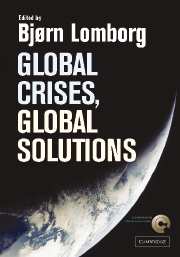Book contents
- Frontmatter
- Contents
- List of figures
- List of tables
- List of boxes
- List of contributors
- Acknowledgements
- List of abbreviations and acronyms
- Introduction
- PART I THE CHALLENGES
- 1 Climate change
- 2 Communicable diseases
- 3 Conflicts
- 4 Access to education
- 5 Financial instability
- 6 Governance and corruption
- 7 Malnutrition and hunger
- 8 Migration
- 9 Sanitation and access to clean water
- 10 Subsidies and trade barriers
- PART II RANKING THE OPPORTUNITIES
9 - Sanitation and access to clean water
Published online by Cambridge University Press: 22 September 2009
- Frontmatter
- Contents
- List of figures
- List of tables
- List of boxes
- List of contributors
- Acknowledgements
- List of abbreviations and acronyms
- Introduction
- PART I THE CHALLENGES
- 1 Climate change
- 2 Communicable diseases
- 3 Conflicts
- 4 Access to education
- 5 Financial instability
- 6 Governance and corruption
- 7 Malnutrition and hunger
- 8 Migration
- 9 Sanitation and access to clean water
- 10 Subsidies and trade barriers
- PART II RANKING THE OPPORTUNITIES
Summary
Characteristics of the Water Challenge
There has been much talk about a ‘world water crisis’ among water experts for several decades now and among policymakers and the public at large for the last five to ten years. What is this crisis? Is the world running out of water? Has there not been enough investment to make water available to people? In the twentieth century there has been massive investment in water resources development. The world population tripled in the last century, but water use grew sixfold. The governments of the United States and Australia, for example, constructed some 5,000 m3 of water storage infrastructure for each and every one of their citizens. Most of this infrastructure is meant to produce hydroelectricity and to irrigate farm land, while some is meant to control floods and store water for domestic water supply for urban areas. Even more money has been invested in water distribution infrastructure, treatment plants, sewerage and wastewater treatment. Water resources development has been a major part of the investments in developing countries – a key component of bilateral aid, World Bank lending, and domestic investment – and the subject of a water supply and sanitation investment drive called ‘the water decade’ in the 1980s. With all this investment, why is there still a crisis?
- Type
- Chapter
- Information
- Global Crises, Global Solutions , pp. 498 - 540Publisher: Cambridge University PressPrint publication year: 2004
- 9
- Cited by

